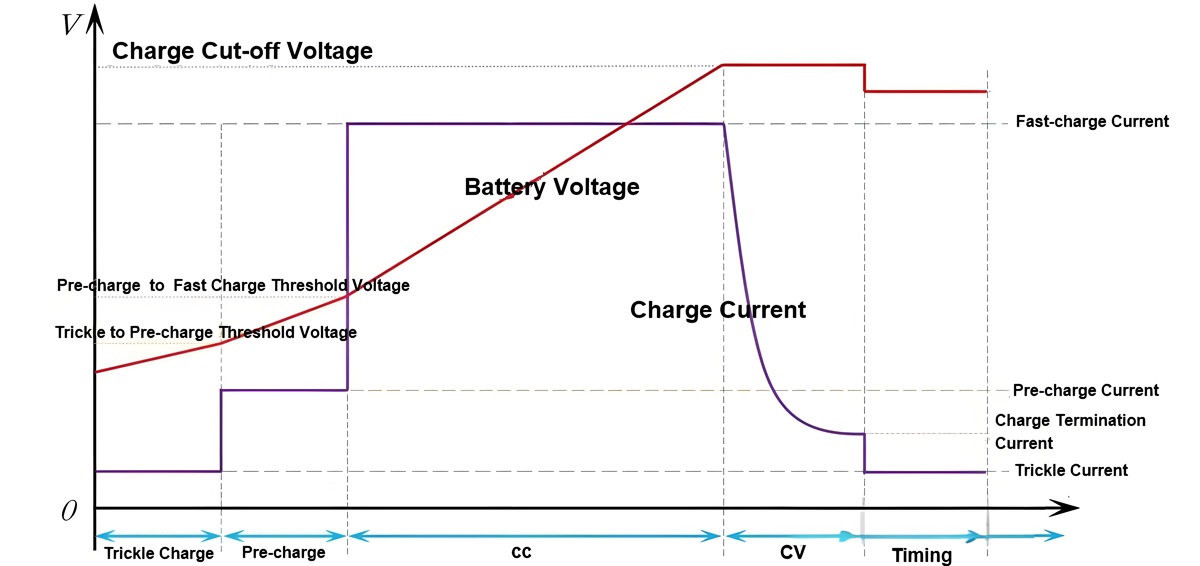With the large-scale use of lithium-ion batteries, from electric vehicles to the current in full swing, no matter how the external system changes or the chemical components of lithium-ion batteries improve,from LiFePO4 battery to NCM/NCA battery, the essence of lithium-ion batteries has not changed substantially, and their charge and discharge characteristics also follow a similar step curve.
1. Characteristics of lithium-ion batteries
Lithium-ion batteries are one of the batteries with the highest energy density. Their single-cell batteries provide higher voltages and withstand larger currents, and do not require trickle charging when the battery is fully charged. However, lithium-ion batteries have no memory effect, which means that they will not "remember" the remaining power before the battery is completely exhausted, so lithium-ion batteries must be charged using a special constant current constant voltage (CC-CV) charging curve, which can be automatically adjusted according to the battery temperature and voltage level.
2. Charging stages of lithium-ion batteries
Stage 1 Trickle Charge
If the battery voltage is lower than VBATT_TC (trickle charge to pre-charge voltage threshold) (2V/cell), the IC will charge the battery with a trickle charge current of 100mA (adjustable). The trickle charge stage is usually only used when the battery voltage is below a very low level (about 2.1V). In this state, the battery pack's internal protection IC may have disconnected the battery due to deep discharge or an overcurrent event. The charger IC provides a small current (usually 50mA) to charge the battery pack's capacitor to trigger the protection IC to close its MOSFET to reconnect the battery. Although trickle charging usually only lasts for a few seconds, the charger IC still needs to integrate a timer. If the battery pack is not reconnected within a certain period of time, it indicates that the battery is damaged and the timer stops charging.
Stage 2 Pre-Charge
Once the battery pack is reconnected or in a discharged state, it enters the pre-charge stage. During pre-charge, the charger IC begins to safely charge the depleted battery at a low current level, which is usually C/10 (C is the capacity in Ah). Pre-charge causes the battery voltage to rise slowly. Its purpose is to safely charge the battery at a low current level to prevent damage to the battery until its voltage reaches a higher level.
Phase 3 Constant Current - CC
Also known as the fast charging phase, constant current charging (CC) begins after pre-charging and begins once the battery voltage reaches approximately 3V per cell (adjustable). During the constant current charging phase, the battery can safely output a higher charging current between 0.5C and 3C. Constant current charging continues until the battery voltage reaches the "full charge" or float voltage level, and then enters the constant voltage charging phase.
Phase 4 Constant Voltage - CV
The constant voltage (CV) threshold for lithium batteries is typically 3.5V to 3.65V per cell. The charger IC monitors the battery voltage during constant current charging. Once the battery reaches the constant voltage charging threshold, the charger IC switches from constant current to constant voltage regulation. Constant voltage charging begins when the charger IC detects that the external battery pack voltage exceeds the actual battery voltage in the battery pack. This is due to the presence of internal battery resistance, PCB resistance, and equivalent series resistance (ESR) from the MOSFET and single cell on the protection board PCM. The charger IC does not allow the battery voltage to exceed its maximum float voltage to ensure safe operation of the charging system.

Stage 5 Stop
During the constant voltage charging stage, when the current flowing into the battery drops below the set threshold (approximately C/10), the charger IC terminates the charging cycle. At this point, the battery is considered fully charged and charging is complete. If the charger IC's charge cutoff function is disabled, the charging current will naturally decay to 0mA, but this is rarely done in practice. Because the amount of charge entering the battery during constant voltage charging decreases exponentially (because the increase in battery voltage acts like a large capacitor), it takes a very long time to charge the battery with very little increase in capacity.